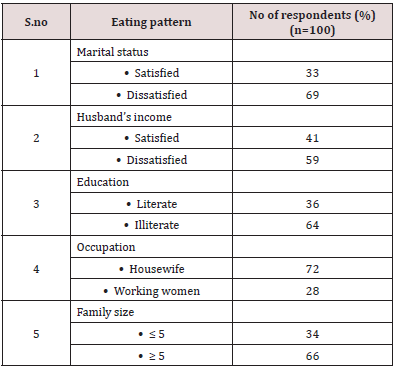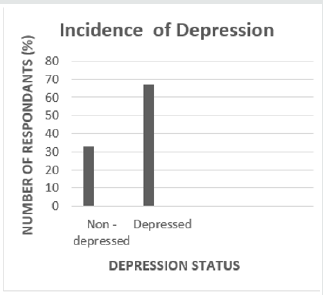Lupine Publishers| Journal of Biomedical Engineering and Biosciences
Abstract
Intense and tenacious feeling of despondency or loss of interest in things that once were enjoyable such condition is termed as Depression which is characterized as a mental illness and contributes a considerable fraction of the inclusive burden of diseases. Determinants of depression among married women includes gender discernment, over burden of work, domestic violence, psychological distress, sexual abuse, women’s poor mental and physical health etc. Identification of potential determinants of depression will possibly aid in devising preemptive strategies in order to reduce its pervasiveness among married women.
Keywords: Depression; Psychological distress; Gender discernment; Cultural bindings; Quetta
Introduction
Depression has been documented as a major mental disorder globally evinced by its fourth position among other diseases [1]. It has been reported that approximately 350 million individuals suffer from it that subsidizes to a high rate of suicide [2]. In Pakistan depression is reported to hold first place among all psychological ailments affecting approximately 29% to 66% women and 10% to 33% of men [3,4]. Depression is intensifying as a major health problem affecting married women with high magnitude than men [5]. Determinants of depression among married women includes gender discernment, over burden of work, domestic violence, psychological distress, sexual abuse, women’s poor mental and physical health etc [6,7]. Besides unforceful life events such as loss of a loved one, subservience, mortification can envisage depression [8]. In addition to that numerous health related issues of married women such as hormonal imbalances, menstrual cycle irregularity, miscarriage, abortion, pregnancy, menopause etc also contributes to high rate of depression [9,10].
A number of married women faces stresses due to over burden of responsibilities both at work and home [11]. Numerous women are also particularly susceptible to postpartum depression after the birth of a baby due to the added responsibility of a new life [12,13]. Married women are reported to be more depressed usually because of her multiple roles as a mother, as a wife, as a daughter-in-law etc and its associated responsibilities [14]. Marital dissatisfaction, family size, occupation, domestic violence, education, cultural setups etc were also reported to be the contributing factors causing depression among married women [15,16]. Quetta city is known for its low countenance, strong customary bindings, cultural reticence, lack of assets and social difficulties [17,18]. Therefore the main purpose of this designed study was to identify the determinants of depression among married women residing in Quetta city and to determine its incidence rate. The reason for choosing married women lies in the fact that married women are more inclined to be depressed that men because they have multiple responsibilities and they are the one who usually faces the ups and downs of life. Consequently, it is important to report this problem to develop mental health sustenance services for women suffering from depression particularly for under developed regional areas.
Materials and Methods
Current study was conducted with the help of a self-developed questionnaire among married women living in different areas of Quetta city, located in the province of Balochistan. The sample size was kept 100.Incidence of depression was measured using 21- item Beck Depression Inventory–II (BDI-II) [19]. The score below 17 indicated non-depressed individuals however score equal to or greater than 17 indicated depressed individuals. Information regarding education, occupation (working status), number of children (family size), husband’s income and marital status was also obtained for the studied respondents.
Results and Discussion
Data in Table 1 shows that a high percentage of married women is facing marital dissatisfaction (69%) which may be due to their husband’s unsatisfactory low earnings as indicated in the mentioned table that 59% of married women were dissatisfied with their husbands’ income causing financial problems. Thus, creating difficulties for such women to support large family. As we all are aware of the concept of combine family system in Pakistan, majority of the households in Quetta has combine family setup which consisted of a large number of dependent individuals relying on a sole independent earning member for their needs [20,21]. Such independent individual is referred as the head of the family and is usually a male. He is responsible for providing the basic necessities of life to his family [22].
And since majority of Pakistani households preferred to have large family size based on their cultural influence and upbringing setups [23]. In such circumstances a low income of the head of the family is not sufficient to support a family of many individuals creating domestic issues which eventually a married woman has to face in the end, leading to mental stress and depression [24,25]. As income is one of the contributing factors of depression, it is well known that women who belongs to low socio-economic group are at elevated risk for depression [26]. Table 1 also indicates that high incidence of depression is mainly due to low literacy rate of married women, only a small percentage of women were literate i.e.36% and a large fraction were reported to be illiterate. According to a study it was reported that educated women were found to be less depressed than low educated or illiterate women because an educated woman is more intellectual and skillful in performing day to day domestic tasks and managing a big household with less mental pressure [27,28]. An educated woman is more fortified with self-sufficiency, decision making capability and confidence [29].
Besides she can also share the financial burden of her husband by doing a job of some kind [30]. Unfortunately working of a female after marriage is not much favored in Pakistani system especially in under developed areas like Quetta due to the narrow mindedness of her male partner or reluctant mentality of her in-laws. Considering the above-mentioned determinants of depression, prevalence rate of this mental disorder was reported to be high i.e.67% among married women as indicted in Table 2 and Graph 1. However, there were several limitations in our study such as information regarding family history of depression, loss of loved ones, current health illness, documentation of domestic violence, sexual abuse, clinical evaluation of women physical/mental health before/after child birth etc which needs to be unveiled in future studies. This study is an endeavor to address the matter of increasing rate of depression among married Pakistani women living in under developed areas to make commendations on how to improve their mental health.
Conclusion
Current study revealed that the overall rate of depression was reported to be high i.e. 67% among married women which is alarming and required clinical diagnosis of depression and its associated treatment. The overall results indicated that depression is high among married women who belongs to a low-income household with large family size. Besides high illiteracy rate is also responsible for depression among married women.
Read More About Lupine Publishers Journal of Biomedical Engineering and Biosciences Please Click on below Link: https://biomedical-sciences-lupine-publishers.blogspot.com/




No comments:
Post a Comment
Note: only a member of this blog may post a comment.